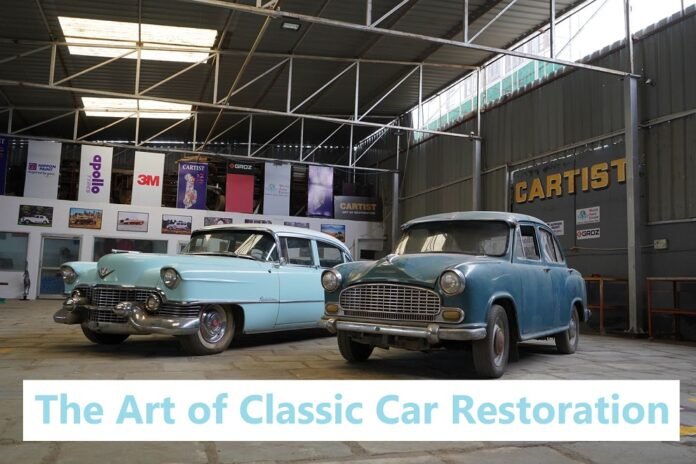Classic cars hold a special place in the hearts of automotive enthusiasts. Their timeless designs, roaring engines, and the nostalgia they evoke make them treasures worth preserving. If you’re embarking on a classic car restoration journey on byotautoparts.com, you’re about to enter a world where time-honored craftsmanship meets passion. But where do you start? In this article, we’ll explore the essential steps of classic car restoration and what comes first in the process.
The Dream Car: Selecting Your Classic Beauty
Before the wrenches and paintbrushes come out, you need to decide which classic car will be your canvas. The first step in any restoration project is selecting the right vehicle. Here’s what to consider:
Must Read: classic car restoration shops
Passion and Connection
Choose a classic car that resonates with you personally. Whether it’s a vintage muscle car, a timeless convertible, or a legendary sports car, your emotional connection to the vehicle will fuel your dedication throughout the restoration process.
Budget
Set a realistic budget for your restoration project. Classic car restoration can be a costly endeavor, so it’s essential to have a clear financial plan in place.
Availability of Parts
Investigate the availability of replacement parts for the make and model you choose. Some classic cars have readily available parts, while others may require more extensive searches or custom fabrication.
Condition
Assess the condition of the car before purchase. A car with minimal rust and mechanical issues will save you time and money in the long run.
Planning and Research: The Blueprint for Success
Once you’ve chosen your classic car, it’s time to roll up your sleeves and start planning. Successful classic car restoration hinges on meticulous research and a well-thought-out plan:
Gather Information
Learn everything you can about your chosen vehicle. Collect manuals, technical documents, and historical information to guide your restoration process.
Set Goals
Determine the level of restoration you want to achieve. Are you aiming for a full, frame-off restoration, or are you looking for a more modest, “driver-quality” restoration? Set clear goals to avoid scope creep.
Create a Timeline
Establish a timeline for your project. Classic car restoration can be time-consuming, so having a schedule in place will help you stay organized and motivated.
Disassembly: Breaking It Down to Build It Up
With a plan in place, it’s time to start disassembling the car. This step involves carefully removing all components, from the engine to the interior, while documenting the process:
Label and Organize
As you disassemble the car, label and organize all parts and components. This step is crucial for ensuring that everything goes back together correctly.
Inspect and Assess
While disassembling, closely inspect each part for damage or wear. Make a list of items that need repair or replacement.
Document Everything
Take photographs and detailed notes throughout the disassembly process. This documentation will be invaluable when it’s time to reassemble the car.
Restoration: From Rust to Glory
The restoration phase is where the magic happens. It involves repairing, refurbishing, and refinishing every aspect of the classic car:
Body and Frame
Address rust and body damage by either repairing or replacing panels and components. Ensure that the frame is straight and free of rust.
Mechanical Systems
Rebuild or replace the engine, transmission, suspension, and brakes. Pay close attention to details like gaskets, seals, and bearings.
Interior
Restore or replace the interior, including seats, carpets, dashboards, and trim. Upholstery and other soft materials may need professional attention.
Paint and Finish
A fresh coat of paint is often one of the most visually striking aspects of a classic car restoration. Choose the right color and finish to capture the car’s original beauty.
Reassembly: Putting the Puzzle Back Together
With all the restoration work complete, it’s time to reassemble the classic car:
Refer to Documentation
Use your documentation from the disassembly phase to guide the reassembly process. Pay close attention to details, as proper assembly is crucial for safety and functionality.
Test and Adjust
As you reassemble components, test them to ensure they function correctly. Make any necessary adjustments or repairs along the way.
Final Touches
Add finishing touches like emblems, badges, and trim to complete the classic car’s look.
The First Turn of the Key: Starting Your Classic Car
After months or even years of hard work, it’s time for the moment of truth. Starting your restored classic car for the first time is a moment of exhilaration and pride:
Safety First
Before starting the engine, double-check that all safety systems, such as brakes and steering, are in working order.
Initial Start
Turn the key and listen for the engine’s roar. It may take a few attempts, but when it comes to life, it’s a rewarding experience.
Fine-Tuning
Expect to fine-tune the engine and other systems as you break into the restored car. Periodic maintenance will be essential to keep it running smoothly.
Classic car restoration is a labor of love, and once your project is complete, it’s time to hit the open road. Your restored classic car becomes a piece of history, a work of art, and a source of joy for years to come. Whether you choose to showcase it at car shows or simply take it out for Sunday drives, your classic car restoration journey is a testament to your dedication and passion for automotive history.
Read More Here



